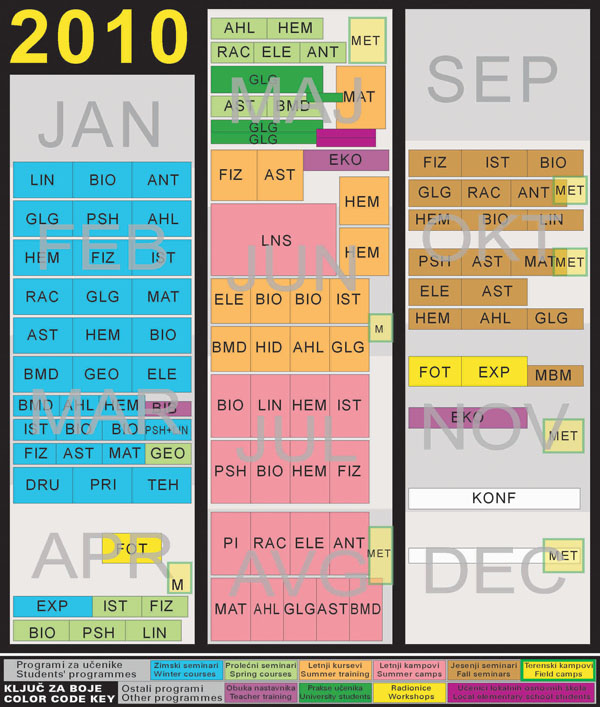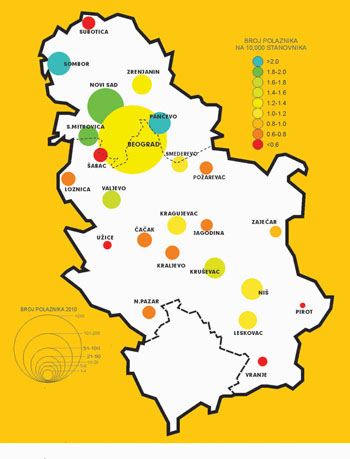PETNIČKI GODIŠNJI CIKLUS
Nije bilo nagoveštaja da će se u leto 2009. na ispit staviti moć Istraživačke stanice Petnica da se suoči sa naglom redukcijom sredstava upravo od partnera koji četvrt veka neprekidno podržavaju njen rad, niti da će to pokrenuti toliki broj mladih i ne samo mladih da se pobune i ponude pomoć i otvorenu podršku. Nenajavljen plebiscit o ulozi i vrednosti Stanice veliko je breme odgovornosti za vreme ispred nas.
Vigor Majić

Na karti ispod prikazali smo zastupljenost polaznika zimskih seminara za srednjoškolce u 2010. godini po grado-vima iz kojih dolaze – ovoga puta analiza je rađena samo za 23 naselja koja zvanično imaju status grada. |

U 2010. godini Istraživačka stanica Petnica organizovala je 115 višednevnih seminara/kampova/radionica sa ukupno 2279 polaznika (od toga 59 nastavnika). Blizu 600 gostujućih saradnika i predavača angažovalo se u realizaciji ovih programa. Na zimske i prolećne seminare odabrano je i pozvano oko 790 srednjoškolaca izabranih iz blizu 950 pristiglih prijava iz 185 srednjih škola. Među srednjoškolcima devojke čine većinu (56 %). |
[Petnica Center]
coursers, camps, workshops 2010
On the opposite page you can see a map of courses, camps and some other educational programs organized in Petnica in 2010. More than 600 guest lecturers from about 130 scientific institutions and universities visited Petnica to take part in the science education programs, to share their knowledge and experience with enthusiastic students.
This complex schedule looks rather chaotic. However, an underlying order and pattern does exist. The schedule was designed to enable the best possible results in short-term programs for students who already attend regular schools. There is an "annual cycle" of educational programs for high-school students, i.e. programs are implemented in four complementary groups. New students first attend a week-long winter course with intensive theoretical work (lectures, demonstrations, discussions). Spring courses are shorter and focused on practical training in instrument manipulation, fieldwork, data acquisition and processing (statistics), etc.
During the two-week summer science camps the students are free to work on small (and sometimes not so small) research project. During this time, they gain precious insight into the real scientific work, including all the difficultiesand problems that exist in professional work.
Fall courses give students a chance to meet again, to discuss results, to finalize their papers, and to hear scientists giving lectures on their work and presenting the latest news from the ever-expanding boundaries of modern science and technology. Participants who successfully complete their results in the form of science papers are invited to participate at the Petnica Annual Students’ Conference, where they have a chance to present their result to other participants and collaborating teachers and scientists. An article of the Annual Conference appears on page 55.
The map illustrates the structure of participants in 2010 comming from Serbian secondary schools (grade 9-12, age 15-19), from 23 major cities and regional centers. Circle diameter is proportional to the number of students taking part in the winter courses 2010 while the color represents the ratio between the number of students and the population of each city.With a total scope of about 115 camps and courses for nearly 2,300 students, innovative and flexible methods, and a broad coverage of various scientific disciplines, the Petnica Science Center continues to be one of the world’s leading centers for extracurricular science education